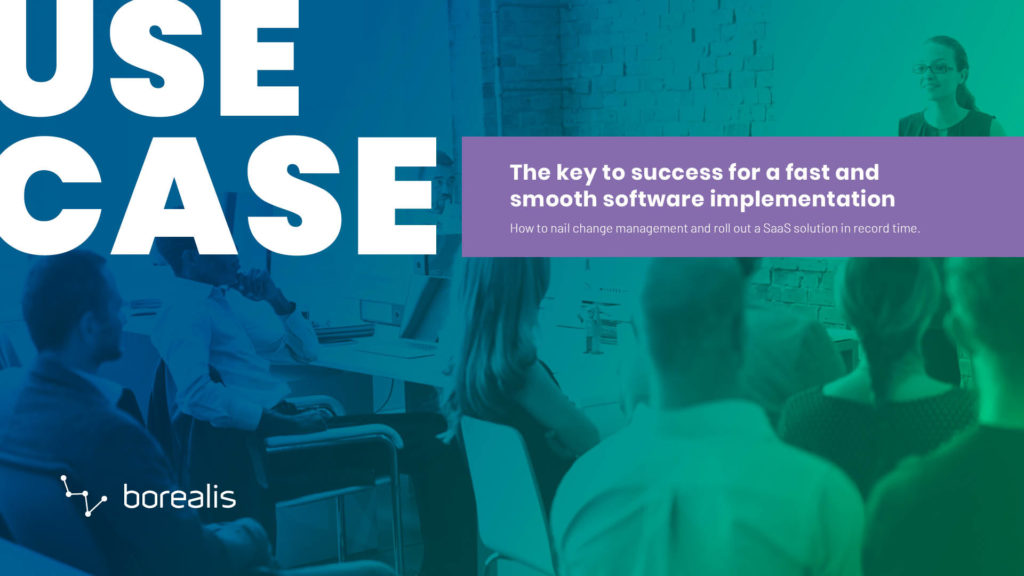“Nothing is permanent except change.”
Heraclitus of Ephesus
Why is a change management plan so important when adopting new software?
Change management is not a new issue. It has concerned organizations for decades, particularly in the last 15-20 years. But while its importance is universally recognized, the figures circulating among experts show that a high number of change management initiatives – about 70% – end in failure.
Digital transformation and the adoption of new technologies – such as new software – require change management programs. But why is it so important to invest in these programs? What are the best practices around change management? And how do you measure the success of the processes you put in place?
To ensure your return on investment
The equation is simple. The more effectively change is managed, the faster the tool will be adopted, and the faster the benefits will be felt – including profits. On the other hand, a poorly managed transition may result in significant costs: lost time, productivity, human resources, etc. Investments in change management are the key to success. Failure to manage change effectively can result in expenses that aren’t just wasteful, but counterproductive.
To create more dynamic user adoption
With proper change management, people better understand the value of the change and become more interested. They make more connections between different elements of the project and ask more questions. As more people quickly adopt the software, user champions emerge as resources for their colleagues. Ultimately, people who are well integrated into the implementation project and who understand the issues at stake can propose improvements, new features, and even new projects.
Adopting new software will certainly affect the activities and responsibilities of many people working in different departments. Don’t underestimate the extent of the changes that are taking place or their impact on your teams’ morale. A carefully thought-out change management plan centered around these human challenges can make all the difference when it comes to acceptance.
Adopting new software is one thing; evolving with it is another. Change management is increasingly becoming a permanent part of organizations as they realize that change never ends. Embracing change management now will help you prepare for the future: once in motion, the wheel of evolution – especially technological – will not slow down or stop.
Keys to success for adopting a new tool
Objectives, deadlines and essential follow-ups
In order to successfully implement a technological solution, it is imperative to set project objectives, but also adoption goals. Therefore, it is important to carefully manage the strategic plan with precise deadlines and essential follow-ups.
Clear, effective, and ongoing communication
To encourage acceptance of a new software, inform your employees about the implementation plan, its necessity, consequences, etc. You may even consider setting up a marketing campaign to “sell” the new tool to everyone who will be affected by its adoption.
Client success
One of our clients chose to train their employees at a location outside their workplace so that they could focus on the activity. They even distributed useful office promotional items (mouse pads, mugs, etc.) with the words “Who is your most important stakeholder today?” to serve as a reminder and positive reinforcement for using the tool.
Once implementation of the new tool is underway, make sure managers understand that they need to monitor their team’s adoption of the platform. While decisions are being made at the senior management level and efforts are focused on user adoption, managers are sometimes left out of the process. However, their role is essential, as their regular supervision allows them to check in with users, supply feedback to upper management, and quickly address any potential issues before they escalate.
Plan to meet goals and targets
Develop a support plan for users. Encourage buy-in by setting short-, medium- and long-term goals, ideally connected to deliverables that need to go through the software. Consider linking annual performance reviews to the adoption of the tool. Regular use of the tool is essential if you want to benefit from its full potential. Monitoring and providing regular feedback to users help establish this routine. For example, weekly usage reports can be very effective toward achieving this goal.
What not to do
A customer decided to wait for his users to adopt the software at their own pace. Nine months later, system use was still lagging. For another client, it took two years. This is why it is so important to set specific adoption targets and timeframes.
Review meaningful conversations as a team
The non-compliant
If you encounter individuals who continue to resist using the system, it may be necessary to meet with them privately and assign specific tasks with definitive deadlines. When dealing with a few stubborn people, some clients decide to stop pressuring them to comply. In many cases, they realize that they are the only one lagging behind. That said, sometimes you do have to tighten the reins to get results.
Client success
A client whose team was resisting system adoption told his employees that from a given date, he would no longer accept emails or Excel documents, only Borealis reports. The result? There was no choice but to comply.
Pilot projects
You may wish to start implementation of the new software with a small project – for one region, department, etc. – and expand from there as you learn and succeed. This is a great way to make sure that you don’t get discouraged by a project that seems too big. It also provides an opportunity to find champions among the early adopters.
Adequate training and support
Focus on training that is complete, relevant, and user-friendly in terms of both content and format. Inadequate training can confuse employees and jeopardize the success of the transition.
Client success
- Provide support materials tailored to each team, based on real-world situations they may encounter: “to do this, follow these steps.”
- In one case where users were being trained in “waves,” a client created an internal Facebook group to share videos and testimonials from the training sessions. This helped motivate people in the subsequent training groups by giving them a better sense of what to expect.
Establish a clear process for providing answers to users’ questions. Who do they go to for this type of problem? Champions are often appointed to assist other employees.
What not to do
At one of our clients, employees who asked for help with an immediate, concrete problem were redirected to multi-page documents… where they had to find a solution themselves. A perfect example of what to avoid.
And more...
Other elements can be added to these good practices, as one of our client case studies shows: a company culture that is not only open to improvement, but also enthusiastic about it, support from the IT team, the use of clean data, etc.

How do you evaluate the success of change management?
Clear objectives and timeline
In addition to facilitating the adoption of the new tool, clear objectives and a well-defined timeline simplify the evaluation exercise, since they provide a baseline for analysis.
Data collection
Managers can help assess the comfort level of their teams. Levels of user adoption can also be measured with satisfaction questionnaires.
Relevant and limited measurement indicators
Performance indicators must be aligned with adoption objectives, but be careful not to multiply them unnecessarily. The calculation of the company’s ROI is an excellent – the first? – barometer to evaluate the success of the project. The two are interconnected, and the success of the organization depends on the success of the project.
Why risk failure?
In an ideal world, no new software implementation would take place without a change management program. The benefits are too great, and the investment certainly outweighs the potential losses if change isn’t managed well.
Changing software is no small thing, and that decision should not be taken lightly. So why take the risk of compromising the success of the company? Good change management allows you to stack the deck in your favor.
Our expertise, your success
At Borealis, we are committed to helping our clients ensure successful adoption of our software, and we’ll accompany you through every step of the transition process.
Our project evaluation questionnaire for future clients includes questions about the desired project deadlines and the consequences of not meeting them. For example:
- What reports do you need? Who are they for? And what will happen if they are not produced on time?
- When do you want to implement the software? What is the consequence if you don’t have it in two months, six months, etc.?
- Do you have other priorities at the same time? What is your current capacity to implement our software?
We know from experience that good change management makes a difference at all stages of the onboarding process, from the first exploratory meeting to the follow-up once the software has been fully implemented. Our goal is to help you maximize your ROI. We have witnessed the mistakes and successes of our many clients, and we are glad to be able to pass these lessons on to you.





